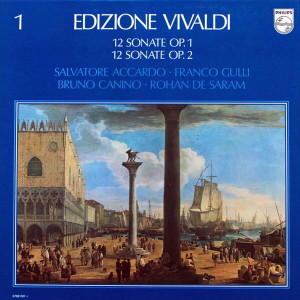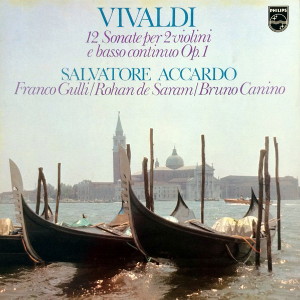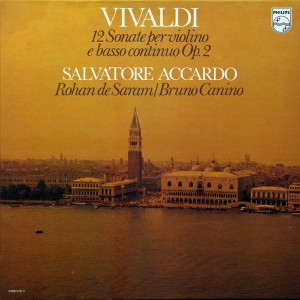 |
|
5 LP's
- 6768 007 - (c) 1978
|
 |
| 2 LP's -
6747 443 - (p) 1977 |
 |
| 3 LP's -
6769 016 - (p) 1978 |
|
| EDIZIONE
VIVALDI - Vol. 1 |
|
|
|
|
|
|
|
| Antonio
Vivaldi (1678-1741) |
|
|
|
|
|
|
|
| Long Playing
1 |
|
48' 13" |
|
| 12 Sonaten op. 1
fŁr 2 Violinen und Continuo |
|
|
|
| -
Nr. 1 g-moll, RV/R. 73 (P.S. 1/1) |
8' 05"
|
|
|
-
Nr. 2 e-moll, RV/R. 67 (P.S. 1/2)
|
8' 39" |
|
|
| -
Nr. 3 C-dur, RV/R. 61 (P.S. 1/3) |
7' 12" |
|
|
|
|
|
|
| -
Nr. 4 E-dur, RV/R.
66 (P.S. 1/4) |
9' 37" |
|
|
| -
Nr. 5 F-dur, RV/R. 69 (P.S. 1/5) |
6' 41" |
|
|
| -
Nr. 6 D-dur, RV/R. 62 (P.S. 1/6) |
7' 59" |
|
|
Long Playing
2
|
|
48' 09" |
|
| -
Nr. 7 Es-dur, RV/R. 65 (P.S. 1/7) |
9' 44" |
|
|
| -
Nr. 8 d-moll, RV/R. 64 (P.S. 1/8) |
12' 22" |
|
|
| -
Nr. 9 A-dur, RV/R. 75 (P.S. 1/9) |
7' 33" |
|
|
|
|
|
|
| -
Nr. 10 B-dur, RV/R. 78 (P.S. 1/10) |
7' 46" |
|
|
| -
Nr. 11 h-moll, RV/R.
79 (P.S. 1/11) |
9' 49" |
|
|
| - Nr. 12
d-moll, RV/R. 63 (P.S. 1/12)
"La Follia" |
11' 12" |
|
|
| Long Playing
3 |
|
50' 55" |
|
| 12
Sonaten op. 2 fŁr Violine und
Continuo |
|
|
|
| -
Nr. 1 g-moll, RV/R. 27 (P.S. 2/1) |
12' 34" |
|
|
| -
Nr. 2 A-dur, RV/R. 31 (P.S. 2/2) |
7' 46" |
|
|
|
|
|
|
| - Nr. 3
d-moll, RV/R. 14 (P.S. 2/3)
|
15'
22"
|
|
|
| -
Nr. 4 F-dur, RV/R.
20 (P.S. 2/4) |
15' 13" |
|
|
| Long Playing
4 |
|
36' 51" |
|
| -
Nr. 5 h-moll, RV/R.
36 (P.S. 2/5) |
8' 42" |
|
|
| -
Nr. 6 C-dur, RV/R. 1
(P.S. 2/6) |
11' 15" |
|
|
|
|
|
|
| -
Nr. 7 c-moll, RV/R.
8 (P.S. 2/7) |
8' 57" |
|
|
| -
Nr. 8 G-dur, RV/R.
23 (P.S. 2/8) |
7' 57" |
|
|
| Long Playing
5 |
|
47' 04" |
|
| -
Nr. 9 e-moll, RV/R.
16 (P.S. 2/9) |
14' 17" |
|
|
| -
Nr. 10 f-moll, RV/R.
21 (P.S. 2/10) |
8' 56" |
|
|
|
|
|
|
| -
Nr. 11 D-dur, RV/R.
9 (P.S. 2/11) |
10' 39" |
|
|
| -
Nr. 12 a-moll, RV/R.
32 (P.S. 2/12) |
13' 12" |
|
|
|
|
|
|
| Salvatore Accardo, Violine |
|
Franco Gulli, Violine
(op. 1)
|
|
| Bruno Canino,
Cembalo |
|
| Rohan de Saram,
Violoncello |
|
|
|
|
|
Luogo
e data di registrazione |
|
Amsterdam
(Olanda) - gennaio 1977 (op. 1)
Amsterdam (Olanda) - novembre 1977
(op. 2)
|
|
|
Registrazione: live /
studio |
|
studio |
|
|
Producer / Engineer |
|
- |
|
|
Prima Edizione
originale LP |
|
Philips
- 6747 443 - (2 LP's) - durata 47'
13" | 48' 09" - (p) 1977 -
Analogico
Philips - 6769 016 - (3 LP's) -
durata 50' 55" | 36' 51" | 47' 04"
- (p) 1978 - Analogico
|
|
|
Note |
|
-
|
|
|
|
|
|
|
SONATAS,
OP. 1
In
the late seventeenth and
early eighteenth centuries
the trio sonata enjoyed in
Italy
a status comparable with
that of the string quartet
in Austria during the late
eighteenth century: it was
a genre which ambitious
young composers often
chose for their first
published opus, and like
the string quartet, whose
originator and guiding
spirit was Haydn,
it possessed universally
recognised models in the
four collections which
Arcangelo Corelli
(1653-1713) brought out
between 1681 and 1694.
Corelli consolidated the
division of the sonata
into two types
corresponding to two
functions. The sonata
da chiesa, or church
sonata, was performed,
like much instrumental
music besides, in church
services and consisted of
a cycle of "abstract"
movements, i. e. movements
characterised solely by a
tempo marking. The sonata
da
camera, or chamber
sonata, was music for the
ballrooms of the nobility,
consisting in the main of
dance movements. The
distinction between these
two sub-types, far from
absolute in Corelliís own
music, tended to weaken as
the new century
progressed. As the growth
of music-publishing in
northern Europe attested,
sonatas increasingly
served purely recreational
purposes, so that the
church-chamber antithesis
became one of style rather
than function, hence more
susceptible to blurring.
The earliest known edition
of the 12 "Suonate
da camera a tre," Op.
1, by Antonio Vivaldi is
that of 1705 by the
Venetian printer Giuseppe
Sala, of which only the
first violin part has
survived. It
is possible that this
edition is a reprint of a
lost earlier edition (of
1703?) by Sala; Vivaldiís
clerical status (he was
ordained in March
1703) is acknowledged on
the title-page but,
unaccountably, not his
post of violin master at
the Ospedale della Pietŗ,
which he had held since
September 1703. It
is also puzzling that the
coat-of-arms of the
dedicatee, the Venetian
nobleman Annibale Gambara,
does not make an
appearance, usual in a
Sala first edition, on the
title-page; instead, Sala
has there his own
typographical emblem -
which one associates with
reprints published at his
own expense.
Vivaldiís conventionally
obsequious dedication
contains an attack on
unnamed critics, who, he
says, "are wont in these
times of flaunt their
insolence." It
was almost customary
among composers to
complain in their first
opus of hostile criticism
(the more abjectly to
fling themselves at their
patronís feet!),
but in Vivaldiís case one
catches a hint of the
paranoia which he was to
reveal so blatantly in his
letters to the Marquis
Guido Bentivoglio 30 years
later.
Like most trio sonatas of
the chamber variety, the
present works are for two
violins and a bass part
designated quite
explicitly on the
title-page for violone
(a common term for
continuo cello) or
harpsichord. Ostensibly,
therefore, the cello and
harpsichord are
alternative, not
complementary,
instruments. Whereas in
churches organs were
always available to join
the stringed bass
instrument and amplify the
texture with continuo
harmonies, harpsichords
would not always have been
to hand for the
performance of chamber
sonatas, particularly in
an outdoor setting; this,
and the light, more
homophonic style of dance
movements, may account for
the convention of
providing a single
partbook for the bass. It
should be pointed out,
nevertheless, that some
contemporary sources
possess duplicate bass
parts, suggesting that,
where resources permitted,
performers were glad to
have both a cello and a
harpsichord.
Vivaldiís sonatas follow
the traditional da
camera plan. An
abstract opening movement,
generally modelled on the
slow introductory movement
of the sonata da
chiesa and entitled
"Preludio",
introduces a series of two
or three dance movements
in binary form chosen from
the standard types:
Allemanda, Corrente,
Sarabanda, Giga, and
Gavotta. The Allemanda is
a moderately quick dance
in common time, the
Corrente and Sarabanda
quickish dances (with
slightly differing
rhythmic stylisation) in
triple time, the Giga an
energetic dance (made
slightly grotesque by its
wide leaps) in compound
time, and the Gavotta a
brief, very quick dance in
duple or quadruple time. In
the Sonatas Nos. 1, 3, 6,
8, and 9 Vivaldi,
following Corellian
precedent, inserts short
abstract movements in slow
tempo for the sake of
variety.
The Op.1sonatas are the
only works by Vivaldi so
far known to merit the
description "immature."
This comes out, first, in
his over-addiction to
certain Corellian formulas
(which he may, of course,
have picked up at second
hand) and, second, in the
lack of control in some of
his experimentation. The
opening of the Preludioto
the first sonata,where the
violins leapfrog over one
another, is purest
Corelli, as is the
composite opening movement
of the fourth sonata. The
fifth sonata is greatly
indebted in melody and
harmony to Corelliís
Violin Sonata, op. 5, No.
10
(1700).
The last sonata is a
special case. Sonatas
conceived as a single,
long variation movement,
like the chaconnes in
Corelliís Op. 2 and
Purcellís "Sonatas in Four
Parts," were a recognised,
if rare, form of chamber
sonata. The last sonata of
Corelliís Op. 5, a set of
variations on a 16-bar
theme in chaconne rhythm,
reputedly of Spanish
origin, known as "La
follia"
(Madness), spawned a host
of direct imitations,
including follie
by T. A. Vitali (Op. 4,
1701), Albicastro (Op. 5,
1703), and Reali (Op. 1,
1709). Vivaldiís
imagination, like that of
Liszt or Ravel, was
stimulated by the demands
of virtuosity (inherent in
a variation movement,
where little changes apart
from the figuration),
making this sonata one of
the best in the set and
worthy to stand beside its
model.
An example of Vivaldiís
striving for originality
at its least successful is
the chromatic Preludio of
the third sonata. Some of
the effects strike home:
the ostinato
figuration of the
Capriccio in Sonata No. 1;
the lyrical triplets in
the Allemanda of Sonata
No. 7; the unaccompanied
bass at the start of the
unusually extended Gavotta
in Sonata No. 10; the
opening on first violin
alone (with a "fade-out"!)
of the
Giga in Sonata No. 11, and
the written-out varied
reprises in the following
Gavotta.
Vivaldi left eight extant
sonatas for two violins
and bass besides those
comprising Op. 1, none
exactly comparable. The
two chamber sonatas in Op.
5 (1716) are heavily
influenced by the style of
the "solo"
sonata (in whose company
they appear), while four
works preserved in Turin
manuscripts are really
violin duos with optional
bass. The remaining works
consist of a probably
unauthentic church sonata
in Wiesentheid
and a sonata of mixed
church-chamber type in
Lund. Vivaldiís Op. 1,
therefore, offers unique
evidence of his schooling
in, and contribution to,
one of the main genres of
his youth and early
manhood.
SONATAS, OP. 2
On December 20, 1708 the
Venetians learned that the
young
king Frederik IV of
Denmark and Norway who had
much enjoyed an earlier
visit in 1693 when still
crown prince, intended to
renew his acquaintance
with their city and sample
the delights of its
carnival. This was to be
no official state visit,
as Frederik did not wish
to be distracted by regal
cares; where protocol
demanded a rank, he was to
be known merely as Count
of Oldenburg, one of his
minor titles. Feverish
preparations were made to
receive the visitor; four
nobles agreed to act as
hosts and the savant
Scipione Maffei
was engaged as the Kingís
guide.
Frederik made his entry on
Saturday December 29, and
paid his first visit to
the opera the same
evening. Next morning he
attended Mass in the
chapel of the Pietŗ.
The service included a
Credo and an Agnus Dei
with instrumental
accompaniment as well as
instrumental music.
Francesco Casparini, the
Pietŗís
musical director, was
absent (perhaps he was
supervising rehearsals of
a new opera, "Engelberta,"
of which he was joint
composer); his place at
the rostrum was taken by
an unidentified "maestro."
It
is very possible that this
deputy was none other than
Vivaldi. At any rate he
can hardly have failed to
take part in the
performance and make
himself known to the king.
This chance encounter soon
bore fruit.
Already in late 1708 the
printer Antonio Bortoli
had announced the
impending publication of a
collection of violin
sonatas, Op. 2, by
Vivaldi, in a catalogue
brought out together with
the libretto of Caldaraís
opera "Sofonisba."
Vivaldi seized this golden
opportunity to dedicate
the works to Frederik.
Perhaps he was in time
to present a copy of
his new publication to
Frederik before the king
departed from Venice, on
March 6,1709.
If
Vivaldiís Op. 1 can be
regarded as an almost
mandatory act of homage to
his elder contemporary
Corelli, Op. 2 shows equal
deference to the Roman
master, modelling itself,
like countless
contemporary collections,
on Corelliís Op. 5. More
precisely, the second half
of the Corelli opus, which
contains six chamber
sonatas (the first half
consists of church
sonatas), is the
starting-point. The
Italian sonata da
camera differs from
the keyboard suite in that
the order of the dances is
flexible. In
Vivaldiís Op. 2, for
instance, the giga is the
concluding dance in the
second, third, fifth,
sixth, and tenth sonatas,
but becomes the opening
dance in the first and
eighth sonatas. However,
the gavotta, the
briefest and lightest of
the dances, never occupies
other than last position.
In
some of his sonatas
Vivaldi substitutes on "abstract"
movement for a dance
movement. The second,
third, and twelfth have
short through-composed grave,
or adagio
movements akin in style to
the internal slow movement
of a church sonata; while
the fast movements
variously entitled capriccio
(Nos.9 and12) and fantasia
(No.11) stretch the
technique of the
performers almost in the
spirit of the emerging
solo concerto.The Preludio
a capriccio of the
second sonata opens like
the very first sonata of
Corelliís Op. 5, adagio
sections alternating with
arpeggiated cadenzas over
pedal points, but rather
surprisingly continues as
a through-composed presto.
The bass part in Op. 2
(the title page gives the
harpsichord as the
accompanying instrument)
is more active than in any
of Vivaldiís later
collections of solo
sonatas. Sometimes it has
virtuosic "divisions"
- elaborations in short
note-values of a simple
harmonic foundation, as in
the closing section of the
Preludio
a capriccio
just cited. Often,
however, the bass shares
the principal thematic
material in imitative
fashion with the violin,
so that the two parts have
a high degree of
interdependence. Already
in Op. 5, published as a
sequel to Op. 2, the bass
is less adventurous; in
the 12 "Manchester"
sonatas, a manuscript set
dating from no earlier
than c. 1725, it has
become a mere rhythmic -
scarcely even harmonic - prop.
One has to go back to Op.
2, rooted in an older
tradition, to find good
examples in Vivaldiís
music of contrapuntal
writing in two parts.
Whereas the Op. 1 trio
sonatas have moments of
gaucheness due to
inexperience, the Op. 2
sonatas are fully mature
in regard to compositional
technique. Stylistically
they are less mature as,
on one hand, they are
greatly indebted to
Corelli for their rhythmic
stylisation and the cast
of their themes and, on
the other, they contain
relatively few of the
Vivaldian idiosyncrasies
richly in evidence from
Op. 3 (1711) onwards. A
much-cited example of such
indebtedness is the Allemanda
of the fourth sonata,
which begins with the same
melodic and harmonic
outline as the Gavotta
in Corelli's
tenth sonata (other
variants of the same idea
appear in the F major
works in Vivaldiís Op. 1
and Op. 3). Because of
this close adherence to
Corellian norms the
sonatas of Vivaldi's
Op. 2 bear a strong
likeness to numerous
contemporary works
for the same medium,
including Handelís Op. 1
and Albinonrs Op. 6. No
other works by Vivaldi are
closer to the mainstream
of Italian
instrumental music.
It
remains to single out a
few movements for special
mention. The
recitative-like Adagio
of the second sonata, a
mere eight bars in length,
opens and closes in the
relative minor key (unlike
the church sonata, the
chamber sonata rarely has
a movement in a foreign
key). Invertible
counterpoint is charmingly
displayed in the Preludio
of the fourth sonata. The
Corrente of the
same work was included in
the anthology "Medulla
musicae"
published in London c.
1727, where it was
mistakenly attributed to
Michele Mascitti (c.
1664-1760). (English
musicians must have been
very familiar with
Vivaldiís Op. 2 through
the pirated edition by
Roger of Amsterdam as well
as a native edition by
Walsh.) The broad sweep of
the violin and bass lines
and some unusually
wide-ranging modulation
lend memorability to the Preludio
of the ninth sonata, whose
Capriccio generates
great excitement with its
quick-fire imitations. The
bubbling Capriccio
of the twelfth sonata
shows the closeness of
Vivaldi the composer to
Vivaldi the performer and
points in the direction of
"LíEstro
armonico."
Michael
Talbot
|
|

